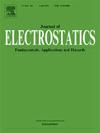一种利用电流探头获取火花放电起始电压的方法
IF 1.9
4区 工程技术
Q3 ENGINEERING, ELECTRICAL & ELECTRONIC
引用次数: 0
摘要
当储存电容较小时(约或低于 100 pF),在火花放电发生前的短暂延迟期间,电极上通常会出现明显的电压降。这会导致电容器能量下降,从而可能导致高估尘埃云的最小点火能量(MIE)。因此,我们开发了一种利用电流探头获取起始放电电压的方法。首先,测量没有火花放电时电极上的电压衰减,从而准确计算寄生电容。随后,根据测量到的火花电流计算火花放电中的起始放电电压,从而确定火花放电前的电容器能量。结果表明,根据计算出的起始放电电压拟合的电流曲线与实际火花电流曲线一致,表明起始放电电压的计算值与实际情况相符。该方法有效解决了在存储电容较小的情况下测量起始放电电压的难题,有助于计算电容器在火花放电前的能量,用于对静电放电高度敏感的尘埃云进行 MIE 测试。本文章由计算机程序翻译,如有差异,请以英文原文为准。
A method of obtaining inception voltage in spark discharge utilizing a current probe
There is usually a significant voltage drop on the electrode during the brief delay before spark discharge occurs when the storage capacitance is small (around or below 100 pF). This leads to a decrease in capacitor energy, which may result in an overestimation of the minimum ignition energy (MIE) of dust cloud. A method that utilizes a current probe to obtain the inception discharge voltage was therefore developed. Firstly, the voltage attenuation on the electrode without spark discharge is measured, enabling an accurate calculation of parasitic capacitance. Subsequently, the inception discharge voltage in a spark discharge is calculated based on the measured spark current, thereby enabling the determination of capacitor energy before spark discharge. The results show that the fitted current curves based on the calculated inception discharge voltage exhibited consistency with the actual spark current curves, indicating that the calculated value of inception discharge voltage was consistent with the actual situation. The method effectively addresses challenges associated with measuring the inception discharge voltage in cases of small storage capacitance, which helps to calculate the capacitor energy before spark discharge for MIE testing of dust clouds that are highly sensitive to electrostatic discharge.
求助全文
通过发布文献求助,成功后即可免费获取论文全文。
去求助
来源期刊

Journal of Electrostatics
工程技术-工程:电子与电气
CiteScore
4.00
自引率
11.10%
发文量
81
审稿时长
49 days
期刊介绍:
The Journal of Electrostatics is the leading forum for publishing research findings that advance knowledge in the field of electrostatics. We invite submissions in the following areas:
Electrostatic charge separation processes.
Electrostatic manipulation of particles, droplets, and biological cells.
Electrostatically driven or controlled fluid flow.
Electrostatics in the gas phase.
 求助内容:
求助内容: 应助结果提醒方式:
应助结果提醒方式:


